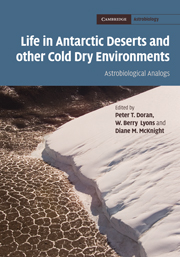Book contents
- Frontmatter
- Contents
- List of contributors
- 1 Introduction
- 2 Geologic analogies between the surface of Mars and the McMurdo Dry Valleys: microclimate-related geomorphic features and evidence for climate change
- 3 The legacy of aqueous environments on soils of the McMurdo Dry Valleys: contexts for future exploration of martian soils
- 4 The antarctic cryptoendolithic microbial ecosystem
- 5 Antarctic McMurdo Dry Valley stream ecosystems as analog to fluvial systems on Mars
- 6 Saline lakes and ponds in the McMurdo Dry Valleys: ecological analogs to martian paleolake environments
- 7 The biogeochemistry and hydrology of McMurdo Dry Valley glaciers: is there life on martian ice now?
- 8 Factors promoting microbial diversity in the McMurdo Dry Valleys, Antarctica
- 9 Other analogs to Mars: high-altitude, subsurface, desert, and polar environments
- Index
- References
6 - Saline lakes and ponds in the McMurdo Dry Valleys: ecological analogs to martian paleolake environments
Published online by Cambridge University Press: 06 July 2010
- Frontmatter
- Contents
- List of contributors
- 1 Introduction
- 2 Geologic analogies between the surface of Mars and the McMurdo Dry Valleys: microclimate-related geomorphic features and evidence for climate change
- 3 The legacy of aqueous environments on soils of the McMurdo Dry Valleys: contexts for future exploration of martian soils
- 4 The antarctic cryptoendolithic microbial ecosystem
- 5 Antarctic McMurdo Dry Valley stream ecosystems as analog to fluvial systems on Mars
- 6 Saline lakes and ponds in the McMurdo Dry Valleys: ecological analogs to martian paleolake environments
- 7 The biogeochemistry and hydrology of McMurdo Dry Valley glaciers: is there life on martian ice now?
- 8 Factors promoting microbial diversity in the McMurdo Dry Valleys, Antarctica
- 9 Other analogs to Mars: high-altitude, subsurface, desert, and polar environments
- Index
- References
Summary
Introduction
On the basis of the prevalence of cold environments in our solar system, the search for extraterrestrial life is focused largely on icy habitats. The McMurdo Dry Valleys (MDV) area is a polar desert with a mean annual temperature below freezing and extremely low humidity (Wharton et al.,1995) and thus offers a suitable earthly analog to our nearest exobiological candidate, Mars. Water is thought to have been abundant on Mars early in its geological history (Solomon et al., 2005; Squyres et al., 2006; Head and Marchant, this volume, Chapter 2) and perhaps may even have flowed across the surface more recently (Hauber et al., 2005; Head et al., 2005; Malin et al., 2006). Life as we know it requires the presence of liquid water to mediate biochemical reactions for energy as well as a reasonably stable environment in which to grow; therefore the search for extraterrestrial life has been largely a search for environments where liquid water can be maintained for some duration (e.g., Carr, 1983).
There is significant geomorphological evidence, and mounting physical evidence supporting the presence of paleolakes on ancient Mars (Squyres et al., 2006). This intrigues exobiologists because paleolakes would provide a suitable habitat for early martian life forms (Carr, 1983; Wharton et al., 1995; Doran et al., 2004). Lakes on the martian surface would have become progressively colder over geological time, developing seasonal and eventually perennial ice covers (Carr, 1983).
- Type
- Chapter
- Information
- Life in Antarctic Deserts and other Cold Dry EnvironmentsAstrobiological Analogs, pp. 160 - 194Publisher: Cambridge University PressPrint publication year: 2010
References
- 10
- Cited by

